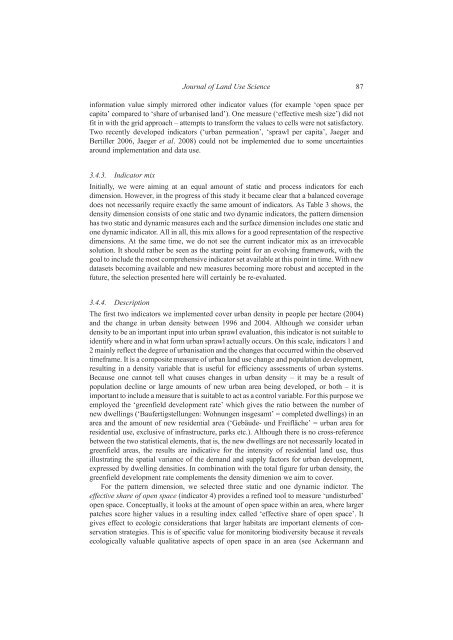PDF 20.134kB - TOBIAS-lib - Universität Tübingen
PDF 20.134kB - TOBIAS-lib - Universität Tübingen
PDF 20.134kB - TOBIAS-lib - Universität Tübingen
Erfolgreiche ePaper selbst erstellen
Machen Sie aus Ihren PDF Publikationen ein blätterbares Flipbook mit unserer einzigartigen Google optimierten e-Paper Software.
Journal of Land Use Science 87<br />
information value simply mirrored other indicator values (for example ‘open space per<br />
capita’ compared to ‘share of urbanised land’). One measure (‘effective mesh size’) did not<br />
fit in with the grid approach – attempts to transform the values to cells were not satisfactory.<br />
Two recently developed indicators (‘urban permeation’, ‘sprawl per capita’, Jaeger and<br />
Bertiller 2006, Jaeger et al. 2008) could not be implemented due to some uncertainties<br />
around implementation and data use.<br />
3.4.3. Indicator mix<br />
Initially, we were aiming at an equal amount of static and process indicators for each<br />
dimension. However, in the progress of this study it became clear that a balanced coverage<br />
does not necessarily require exactly the same amount of indicators. As Table 3 shows, the<br />
density dimension consists of one static and two dynamic indicators, the pattern dimension<br />
has two static and dynamic measures each and the surface dimension includes one static and<br />
one dynamic indicator. All in all, this mix allows for a good representation of the respective<br />
dimensions. At the same time, we do not see the current indicator mix as an irrevocable<br />
solution. It should rather be seen as the starting point for an evolving framework, with the<br />
goal to include the most comprehensive indicator set available at this point in time. With new<br />
datasets becoming available and new measures becoming more robust and accepted in the<br />
future, the selection presented here will certainly be re-evaluated.<br />
3.4.4. Description<br />
The first two indicators we implemented cover urban density in people per hectare (2004)<br />
and the change in urban density between 1996 and 2004. Although we consider urban<br />
density to be an important input into urban sprawl evaluation, this indicator is not suitable to<br />
identify where and in what form urban sprawl actually occurs. On this scale, indicators 1 and<br />
2 mainly reflect the degree of urbanisation and the changes that occurred within the observed<br />
timeframe. It is a composite measure of urban land use change and population development,<br />
resulting in a density variable that is useful for efficiency assessments of urban systems.<br />
Because one cannot tell what causes changes in urban density – it may be a result of<br />
population decline or large amounts of new urban area being developed, or both – it is<br />
important to include a measure that is suitable to act as a control variable. For this purpose we<br />
employed the ‘greenfield development rate’ which gives the ratio between the number of<br />
new dwellings (‘Baufertigstellungen: Wohnungen insgesamt’ = completed dwellings) in an<br />
area and the amount of new residential area (‘Gebäude- und Freifläche’ = urban area for<br />
residential use, exclusive of infrastructure, parks etc.). Although there is no cross-reference<br />
between the two statistical elements, that is, the new dwellings are not necessarily located in<br />
greenfield areas, the results are indicative for the intensity of residential land use, thus<br />
illustrating the spatial variance of the demand and supply factors for urban development,<br />
expressed by dwelling densities. In combination with the total figure for urban density, the<br />
greenfield development rate complements the density dimenion we aim to cover.<br />
For the pattern dimension, we selected three static and one dynamic indictor. The<br />
effective share of open space (indicator 4) provides a refined tool to measure ‘undisturbed’<br />
open space. Conceptually, it looks at the amount of open space within an area, where larger<br />
patches score higher values in a resulting index called ‘effective share of open space’. It<br />
gives effect to ecologic considerations that larger habitats are important elements of conservation<br />
strategies. This is of specific value for monitoring biodiversity because it reveals<br />
ecologically valuable qualitative aspects of open space in an area (see Ackermann and

















